The "backbone" of stigma: identifying the global core of public prejudice associated with mental illness
- PMID: 23488508
- PMCID: PMC3698809
- DOI: 10.2105/AJPH.2012.301147
The "backbone" of stigma: identifying the global core of public prejudice associated with mental illness
Abstract
Objectives: We used the Stigma in Global Context-Mental Health Study to assess the core sentiments that represent consistent, salient public health intervention targets.
Methods: Data from 16 countries employed a nationally representative sampling strategy, international collaboration for instrument development, and case vignettes with Diagnostic and Statistical Manual of Mental Disorders, Fourth Edition depression and schizophrenia criteria. We measured knowledge and prejudice with existing questions and scales, and employed exploratory data analysis to examine the public response to 43 items.
Results: Across countries, levels of recognition, acceptance of neurobiological attributions, and treatment endorsement were high. However, a core of 5 prejudice items was consistently high, even in countries with low overall stigma levels. The levels were generally lower for depression than schizophrenia, and exclusionary sentiments for more intimate venues and in authority-based roles showed the greatest stigma. Negative responses to schizophrenia and depression were highly correlated across countries.
Conclusions: These results challenge researchers to reconfigure measurement strategies and policymakers to reconsider efforts to improve population mental health. Efforts should prioritize inclusion, integration, and competences for the reduction of cultural barriers to recognition, response, and recovery.
Figures



References
-
- Link BG, Yang L, Phelan JC, Collins P. Measuring mental illness stigma. Schizophr Bull. 2004;30(3):511–541 - PubMed
-
- Martin JK, Pescosolido BA, Olafsdottir S, McLeod JD. The construction of fear: modeling Americans’ preferences for social distance from children and adolescents with mental health problems. J Health Soc Behav. 2007;48(1):50–67 - PubMed
Publication types
MeSH terms
Grants and funding
LinkOut - more resources
Full Text Sources
Other Literature Sources
Medical

